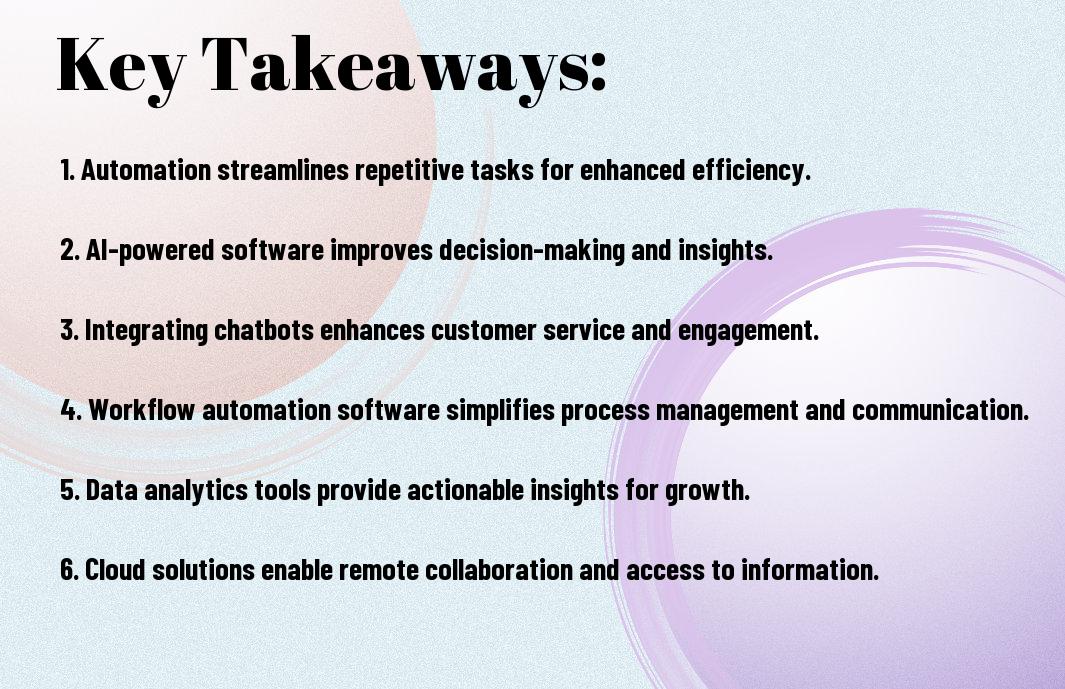Business efficiency is more important than ever as we move toward 2025, and leveraging the right automation tools can significantly enhance your operations. In this blog post, you’ll discover seven must-have tools that can streamline your processes, boost productivity, and save you valuable time. Whether you’re a small startup or an established enterprise, these automation solutions will empower you to focus on growth while minimizing manual intervention. Let’s look into the tools that are set to transform your business landscape in the near future.
Key Takeaways:
- Automation tools enhance efficiency by streamlining repetitive tasks, allowing teams to focus on strategic initiatives.
- Integration capabilities are imperative, enabling different software solutions to work together seamlessly and enhance overall productivity.
- Data analytics tools provide valuable insights that can drive informed decision-making and improve business strategies.
- Cloud-based automation solutions offer flexibility and scalability, making it easier for businesses to adapt to changing needs.
- User-friendly interfaces and training resources are important for ensuring team members can effectively utilize automation tools.

The Importance of Automation in Business
The rise of automation in business is transforming the way you operate and make decisions. By streamlining processes and minimizing human intervention, automation enables you to focus on strategic tasks that drive growth and innovation. As technology continues to evolve, embracing automation will not only enhance your operational capabilities but also improve customer satisfaction, positioning your company to thrive in a competitive landscape.
Enhancing Efficiency
Between automating repetitive tasks and optimizing workflows, you can significantly enhance your business’s overall efficiency. Automation tools help you allocate resources effectively, reduce errors, and improve turnaround times. This allows your team to invest time in more complex and value-driven projects, ultimately leading to greater productivity and improved performance.
Cost Reduction
Around 30% of operational costs can be reduced through effective automation. By streamlining processes, you minimize the need for additional labor and reduce human errors that lead to costly mistakes. Furthermore, automation can help in reallocating your workforce toward high-value tasks, making your business more agile and responsive to market changes.
To maximize cost reduction through automation, evaluate areas where your resources are being underutilized. Implementing automated tools can help consolidate tasks, eliminating redundancies that eat into your budget. You may also notice savings in time, which translates directly into financial benefits. Over time, the return on your investment in automation can be substantial, allowing you to reinvest those savings into your business for future growth.
Must-Have Tools
Now, as businesses continue to adapt to the rapidly evolving landscape of 2025, incorporating automation tools into your daily operations is important. These tools streamline processes, enhance productivity, and ultimately drive growth. To get you started, check out The 7 Best IT Automation Tools: 10 Things to Consider … for insights on key automation tools you can’t overlook.
Robotic Process Automation (RPA) Tools
Above all, RPA tools enable you to automate repetitive tasks, allowing you to focus on high-value activities. By deploying bots to handle data entry, report generation, or invoice processing, you can reduce operational costs while increasing accuracy and efficiency.
Customer Relationship Management (CRM) Software
For businesses, CRM software is a game-changer. It centralizes customer information, streamlining your interactions and improving relationships. With the right CRM, you gain insights into customer behavior that can guide your strategies.
In fact, leveraging CRM systems helps you to track leads, manage customer data, and facilitate communication. These platforms enable you to personalize outreach, increasing customer satisfaction and loyalty while boosting your sales pipeline.
Marketing Automation Platforms
The implementation of marketing automation platforms empowers you to optimize your marketing efforts. By automating campaigns, analyzing customer engagement, and for segmenting your audience, you can enhance your marketing strategies effectively.
This also saves time and resources, allowing you to focus on creative aspects of your marketing while data-driven workflows handle repetitive tasks, leading to better targeting and higher conversion rates.
Project Management Tools
Between team collaboration, task management, and deadline tracking, project management tools are invaluable for your business. These platforms keep everyone aligned and informed, helping you execute projects efficiently.
Consequently, by utilizing project management software, you can streamline workflows, manage resources effectively, and improve your team’s overall productivity, resulting in timely project completions and satisfied stakeholders.
AI-Powered Analytics
Analytics tools with AI capabilities enable you to gain deeper insights into your data, helping you make informed decisions. By analyzing trends and customer behavior, you can identify opportunities for growth and refine your strategies accordingly.
MustHave AI analytics solutions transform raw data into actionable insights, allowing you to spot trends before they become commonplace and adjust your business strategies to stay ahead of the competition.
Chatbots and Virtual Assistants
Platforms powered by chatbots and virtual assistants enhance customer interactions and provide instant support, improving user experience. These tools can manage common inquiries, facilitate bookings, and resolve issues around the clock.
Customer engagement increases when you incorporate chatbots, freeing your teams from mundane tasks while ensuring that your clients receive prompt and accurate responses whenever they need assistance.
E-signature Solutions
By utilizing e-signature solutions, you streamline document signing processes, allowing contracts and agreements to be executed with ease. This increases the speed and convenience of transactions and reduces the reliance on paper documentation.
Robotic the transition to e-signatures facilitates efficient workflows, enhances security, and promotes eco-friendly practices, making it an important tool for modern businesses looking to optimize their operations without compromising compliance.

Selecting the Right Automation Tools
After identifying your automation goals, it’s necessary to choose tools that align well with your specific business needs. Efforts to select the right software should be informed by thorough research. Check out 15 Business Automation Software Tools to Consider in 2025 to guide you in your decision-making process. A careful assessment will help streamline your operations and enhance productivity.
Assessing Business Needs
Tools that fit seamlessly into your existing workflows and processes will yield the best results. Start by identifying pain points within your operations, and consider which aspects of your business would benefit from automation. Your goals could include improving efficiency, reducing errors, or enhancing customer satisfaction. A clear understanding of your needs will guide you towards selecting the most appropriate automation tools.
Cost-Benefit Analysis
Right from the outset, it’s advisable to conduct a comprehensive cost-benefit analysis of your potential automation solutions. By evaluating the investment required against the anticipated returns in terms of time savings and increased productivity, you can make informed choices that justify your spending and maximize value.
Even minor discrepancies in costs can lead to significant impacts on your overall budget. Don’t just consider the upfront costs; think about ongoing expenses and potential hidden fees. Weigh these against the expected time savings and efficiency gains. By analyzing both tangible and intangible benefits, you’ll ensure that your selected tools truly deliver the value you need for your business.

Implementing Automation Successfully
All businesses can greatly benefit from automation, but success is not guaranteed without a strategic approach. To achieve the desired outcomes, you need to carefully assess your goals, select the right tools, and implement them in a way that aligns with your overall business strategy. Engaging your team in the process will also foster a smoother transition and boost adoption rates, ultimately driving productivity and efficiency throughout your organization.
Training and Support
Training your employees on new automation tools is necessary for successful implementation. When your team understands how to effectively utilize the technology at their disposal, you’ll see improved efficiency and productivity. Providing ongoing support resources, such as tutorials or access to a help desk, ensures that your staff can troubleshoot problems and maximize their proficiency, ultimately enhancing your operations.
Monitoring and Optimization
One of the key aspects of successfully implementing automation is continuous monitoring and optimization of your systems. This involves regularly assessing the performance of your automated processes and making necessary adjustments to improve efficiency and effectiveness.
At the core of effective monitoring and optimization lies data analysis. By tracking performance metrics and user feedback, you can identify bottlenecks or areas for improvement in your automated solutions. Periodically revisiting and refining your automation strategies ensures they evolve alongside your business needs, leading to sustained success and achieving better results over time.
Future Trends in Business Automation
Once again, the landscape of business automation is set to evolve dramatically by 2025. As you look ahead, you’ll notice an increased integration of artificial intelligence and machine learning, enhancing decision-making processes in your operations. Emphasizing user-centric designs will also become paramount, ensuring that the tools you adopt seamlessly fit your workflows. To stay at the forefront, consider exploring The Top 20 Test Automation Tools of 2025, which will help you identify technologies that can propel your business forward in this dynamic environment.
Conclusion
So, as you navigate the ever-evolving landscape of business in 2025, integrating these seven must-have automation tools can significantly enhance your operational efficiency and productivity. By leveraging innovative technologies, you can streamline processes, reduce manual tasks, and focus on strategic growth. Embrace these resources to stay competitive and improve your business outcomes, ensuring you are well-prepared for the future of automation.
FAQ
Q: What are the 7 must-have tools for automation in business in 2025?
A: The 7 must-have tools for automation in business in 2025 include:
- Project Management Software (e.g., Asana, Trello)
- Customer Relationship Management (CRM) Systems (e.g., Salesforce, HubSpot)
- Email Marketing Automation Tools (e.g., Mailchimp, ActiveCampaign)
- Chatbot and Live Chat Solutions (e.g., Drift, Intercom)
- Workflow Automation Platforms (e.g., Zapier, Integromat)
- Social Media Management Tools (e.g., Hootsuite, Buffer)
- Accounting Software with Automation Features (e.g., QuickBooks, Xero)
Q: How can project management software improve business efficiency?
A: Project management software helps streamline tasks by enabling collaboration among team members, tracking deadlines, and providing a comprehensive view of project progress. It allows businesses to allocate resources effectively, prioritize tasks, and minimize the chances of delays, thus improving overall efficiency.
Q: Why is CRM software vital for modern businesses?
A: CRM software is vital as it helps manage customer interactions, track sales performance, and analyze customer data. It improves customer relationships, enhances customer service, and provides insights that allow businesses to tailor their marketing strategies more effectively to meet consumer needs.
Q: What benefits do email marketing automation tools provide?
A: Email marketing automation tools save time by allowing businesses to schedule emails, segment audiences, and personalize content automatically. They also offer analytics to monitor performance, helping businesses refine their strategies and increase engagement and conversion rates over time.
Q: How can chatbots enhance customer service for businesses?
A: Chatbots provide instant responses to customer inquiries, facilitating 24/7 support without requiring human intervention. They can handle a variety of queries, streamline the onboarding process, and gather feedback, ultimately improving customer satisfaction and loyalty.
Q: What role do workflow automation platforms play in operational efficiency?
A: Workflow automation platforms enhance operational efficiency by connecting different applications and automating repetitive tasks. This reduces the need for manual input, minimizes errors, and allows employees to focus on higher-value work, resulting in increased productivity across the organization.
Q: How do accounting software automation features save businesses time and money?
A: Accounting software with automation features helps streamline financial processes such as invoicing, payment tracking, expense management, and financial reporting. By reducing manual entry and calculations, businesses not only save significant time but also minimize the risk of human error, leading to more accurate financial data and potentially lower operational costs.
Q: What is the importance of social media management tools for business growth?
A: Social media management tools allow businesses to schedule posts, monitor engagement, analyze performance metrics, and manage interactions across various platforms all in one place. This creates a strategic approach to social media marketing, helping businesses increase brand visibility, engage with their audience, and drive traffic to their websites, ultimately contributing to growth.



